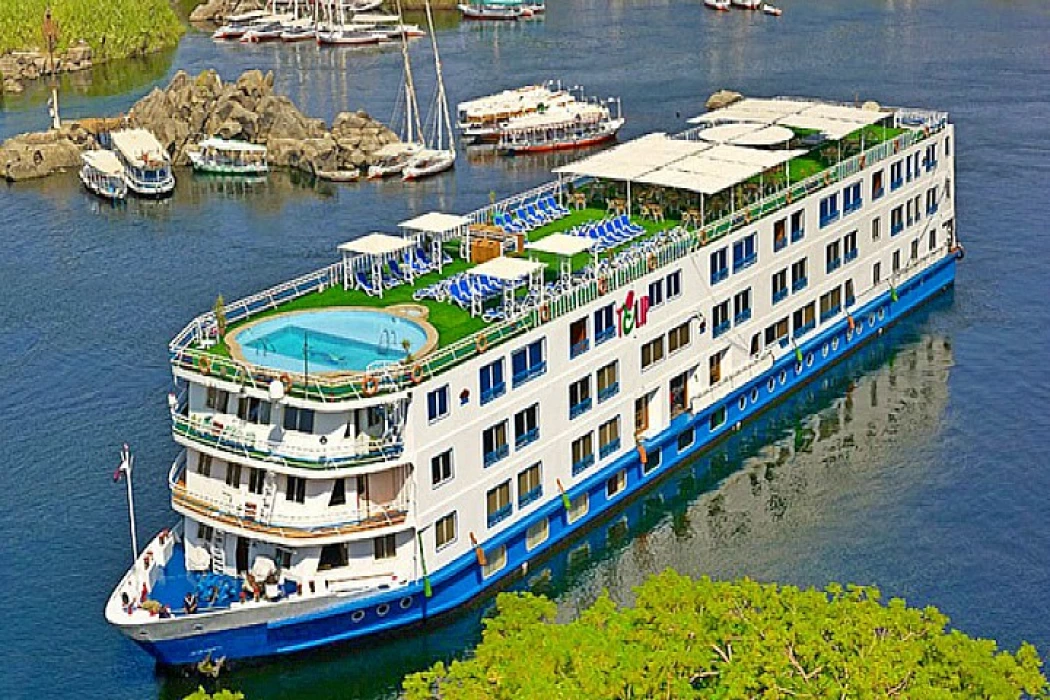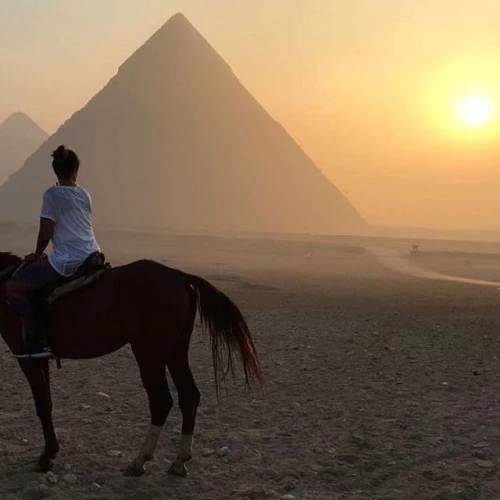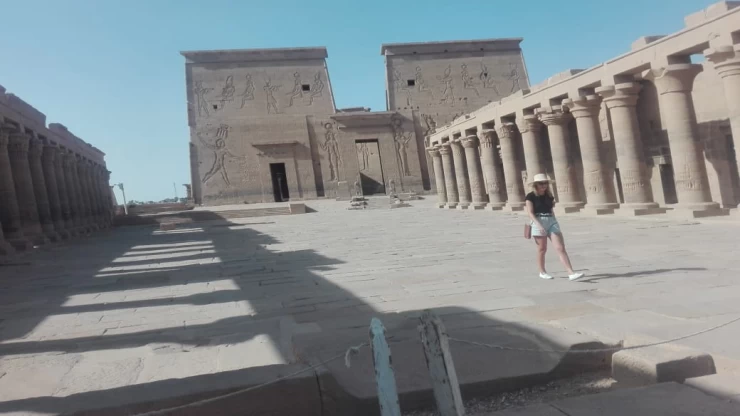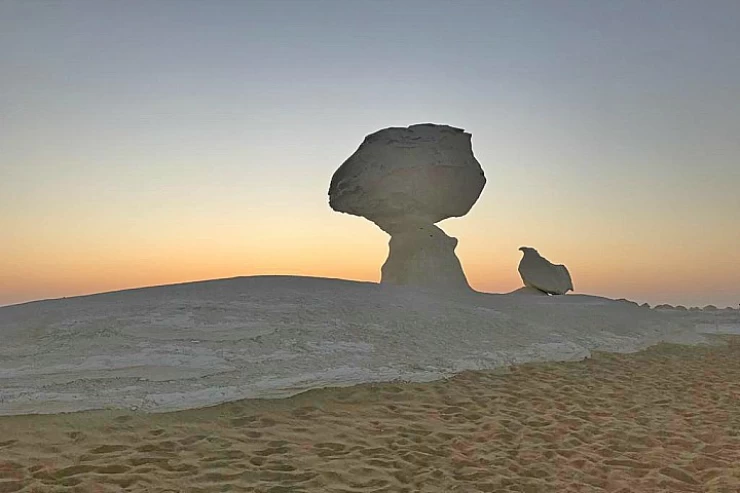
The Nile River information
Information about the Nile River
The Nile River is the longest in the world, measuring about 6,650 kilometers in length, draining an area of about 3,349,000 square kilometers, called the Father of African rivers, and rising south of the equator. It flows north through northeastern Africa before emptying into the Mediterranean Sea. The Nile was utilized 5,000 years ago by ancient Egyptians for freshwater and food; the transportation was eased, and the grounds it provided were good enough for farming. In and around the famous Nile River dwell a lot of animals: frogs, hippos, turtles, over 300 types of birds, and many more.
The Nile carries 110 million tons of silt annually, most from the Abyssinian Plateau, and these amounts of silt play a great role in the basin countries, for it renews the fertility of the soil on both banks.
Places to be visited during the Nile River Cruise
Dendera Temple in Qena
Hathor was one of the most important goddesses in ancient Egypt and was widely worshipped as she was the goddess of the sky, dance, music, and motherhood. Her main cult center was the city of Dendera, and her temple is considered one of the best-preserved temples in all of ancient Egypt. The façade of this temple is also one of the most magnificent façades of ancient Egyptian temples, where six columns crowned with the heads of Hathor top the façade. The main existing Hathor temple dates from the Ptolemaic period, but there is much evidence to indicate that the site was used by King Pepi I of the Sixth Dynasty and is characterized by the astronomical scenes depicted on the ceilings.
Abydos Temple in Sohag:
Abydos Temple, or "Buried Godmother," is located in the city of Balina in Sohag Governorate and is one of the ancient cities of Upper Egypt, dating back 5,000 years BC. It is called the Buried Godmother due to the many monuments found in it under the sand. The temple is characterized by the many inscriptions in it, in addition to being one of the roofed temples.
the High dam
The High Dam has been a big help in the control of water flow and also helped lessen the effect of flooding in the Nile. This is utilized for electricity generation in Egypt. Its length is 3600 meters, the width of the base is 980 meters, the width of the crest is 40 meters, and its height is 111 meters. The body of the dam constitutes 43 million cubic meters of cement, iron, and other materials.
Hatshepsut Temple in Luxor
Queen Hatshepsut (c. 1473-1458 BC) built a magnificent temple in Deir el-Bahri, on the West Bank of Luxor, facing Karnak Temple, the main sanctuary of Amun on the East Bank. It was designed by Senenmut, who held many titles, including director of Amun's estates. The temple has three levels, each of which has a row of columns at its back, and behind the top row of columns is an open court at the top level with statues of Hatshepsut as Osiris, god of the dead.
Luxor Temple
The ancient Egyptians called the Luxor Temple "Ibit Reset," meaning "southern sanctuary," because of its location within ancient Thebes (now Luxor). The temple is located some three kilometers south of the Temple of Karnak, from which it was separated by an avenue bordered on either side by sphinxes and ram-headed sphinxes. The earliest evidence of this temple dates back to the Eighteenth Dynasty (ca. 1550 - 1295 BC).
The temples of Karnak in Luxor reflect the prowess of ancient Egyptians in the arts of construction and sculpture, with walls bearing exquisite carvings, huge statues, and great columns. The most striking and famous part is the Great Hall of Columns of the temple, which contains 134 huge columns. Some of those are up to 15 meters high, except for the five largest columns towards the center. They are to a height of 21 meters. Construction for this hall started during the reign of Amenhotep III, ca. 1390-1352 BC, while the main decoration and construction had been done by Seti I, ca. 1294-1279 BC, and Ramses II, ca. 1279-1213 BC. Standing near these columns are two huge obelisks, one built by Queen Hatshepsut, circa 1473-1458 BC, at about 30 meters high and weighing over 300 tons. Many of the cities stand on the River Nile; hence, it is a lifeline to the country as a whole.
Things to do on board the river cruise
view the quiet evening sunset free from the buzz of the crowded city, or enjoy a nice dinner with some entertainment, while seeing the city you will pass through in an entirely different aspect.
The Nile River is the lifeblood of Egypt, a widely popular waterway that has been shaping civilizations, inspiring legends, and attracting travelers for years from every nook and corner of the world. Whether this means taking a Nile River cruise, planning a visit to historical sites along its banks, or simply wanting to soak in its tranquil beauty, there are indeed many ways to make the most of one's experience. The following are essential tips that would be helpful in exploring some attractions of the river and discovering its timeless charm.
The most popular way to see the river and its attractions is to take a Nile cruise. Most Nile cruises cover the stretch between Luxor and Aswan, with stops at key archaeological sites.
Choose the right type of cruise: Luxury cruises offering five-star amenities, traditional dahabiya sailboats for smaller groups, and more economical options are available.
Book ahead, as cruises can fill quickly, especially during peak winter and early spring seasons. Consider the itinerary: It must include the main sites such as the Valley of the Kings, the Temple of Karnak, Kom Ombo, and the Temple of Philae.
One distinctive pillar of Egypt is the Nile River. However, the short stretch between Aswan and Luxor in southern Egypt is the most interesting part for luxury boating to and from Luxor...The antiquities of this region are not only architectural masterpieces, but also windows into Egyptian civilization.
This stretch is distinguished by the ancient treasures scattered along its banks. It is home to some of the largest and most interesting temples built in ancient times, such as the amazing Karnak Temples, the Valley of the Kings, the Crocodile Museum in Kom Ombo, and the water-bound Philae Island.
This stretch is also characterized by its enchanting nature, which adorns the banks of the Nile like a mosaic, with emerald green farms, palm groves, amber desert, and a ruby-red sky at dusk as the sun sets behind the seemingly endless desert dunes.
Being the route of history buffs, one will find the majority of the famous temples and monuments of Egypt along the bank of the river. Luxor and Karnak Temples: These are extensive temple complexes in Luxor and rank among the most critical ones in ancient Egypt.
Abu Simbel: Lying close to Aswan, these rock-cut temples are a World Heritage Site as per UNESCO declarations and form part of the itinerary of any Nile voyage.
Temple of Edfu and Kom Ombo: Both lying between Luxor and Aswan, these temples display peculiar aspects of ancient Egyptian religion and architecture.
Enjoy the warm winter weather among the stunning landscape and enchanted setting of Aswan with Nile cruises, one of the greatest choices for a journey to the beauty of the South.
Aswan Governorate is adorned during the winter season, welcoming thousands of foreign tourists and Egyptian visitors who flock to southern Egypt during the mid-year and winter holidays to spend a pleasant time surrounded by nature, ancient civilization, and the warm, stable winter weather.
The time of year can greatly affect your experience on the Nile.
High season: October to April has generally mild temperatures, which makes sightseeing easier.
Low season: May to September is hotter; however, you will face fewer crowds and have better deals on cruises and accommodations.
Time of day: Early morning tours will help you avoid midday heat and give you spectacular sunrises over the Nile.
A favorite local activity is taking a felucca and turning it into a sailing party along the Nile Corniche. Felucca rentals are reasonably priced and can be rented by the hour. During this tour, you can play any music you like and take all your favorite food on board. These wooden boats cut through the water and transport you away from the hustle and bustle of the city in minutes. They are also great on a hot summer day, stopping around several points in Cairo.
Consider sailing on a felucca, the traditional Egyptian sailboat, for a more genuine and laid-back experience.
Short rides: These are ideal for sunset or evening trips.
Custom tours: You can book multi-day feluca trips if you want to take it easy and see more of the area at your own pace.
Pack accordingly: Bring sunscreen, comfortable clothing, and water for a comfortable ride.


















